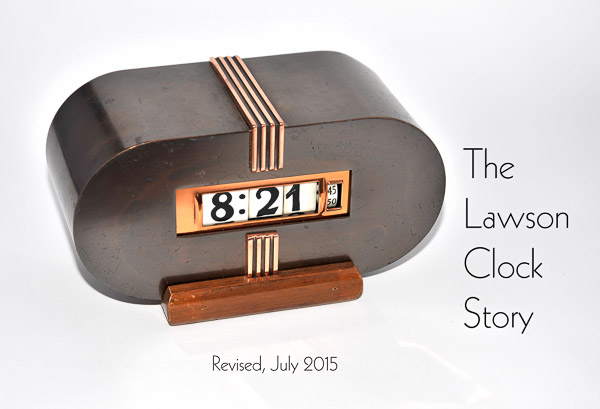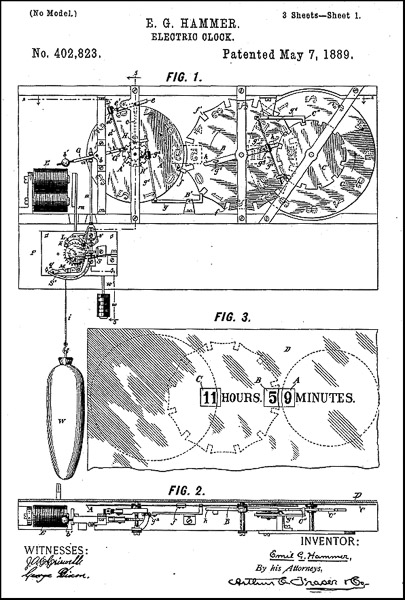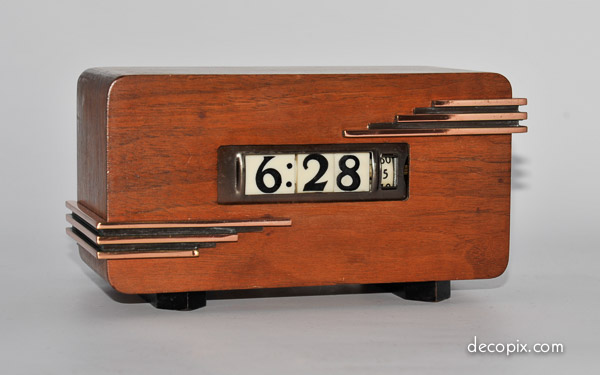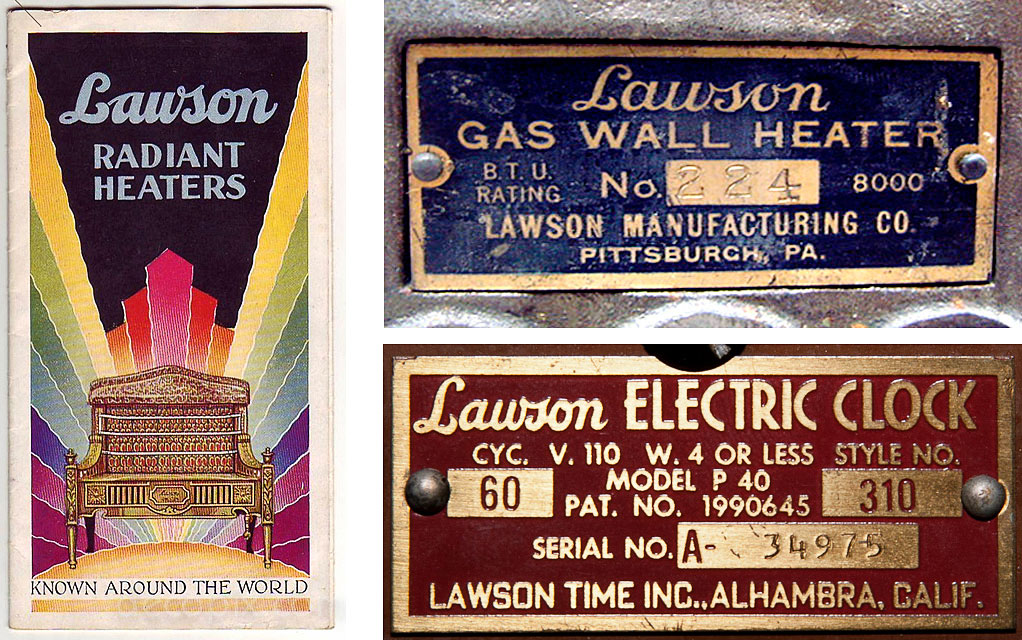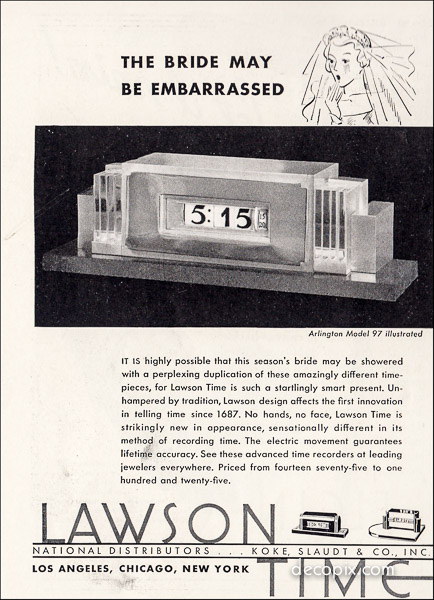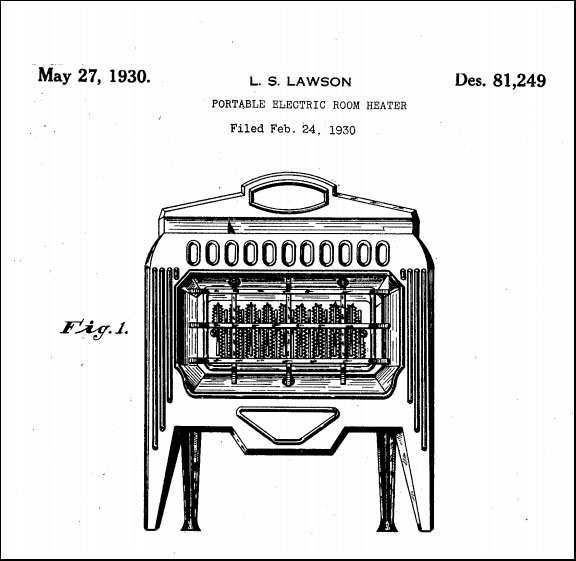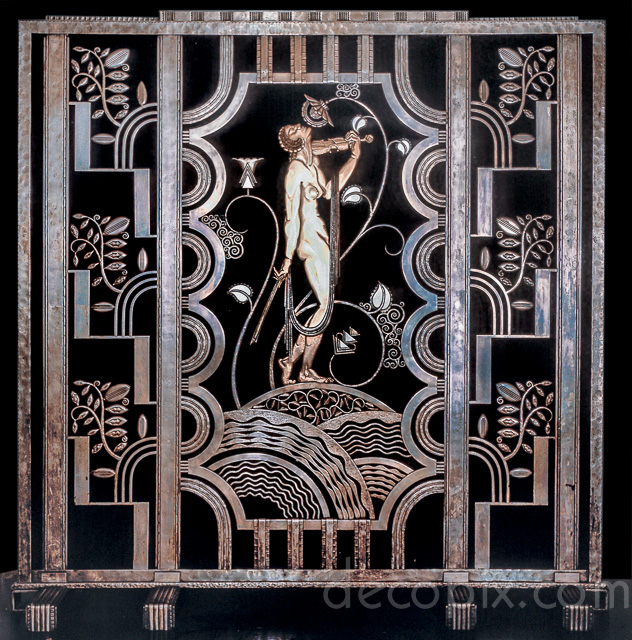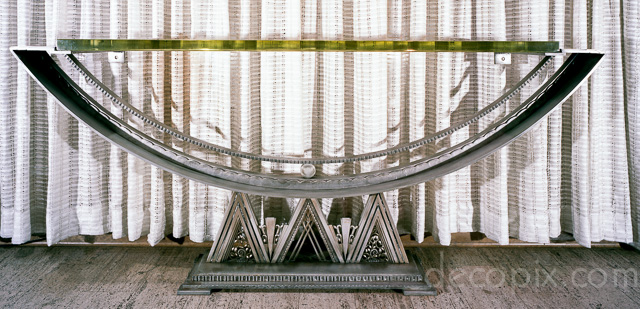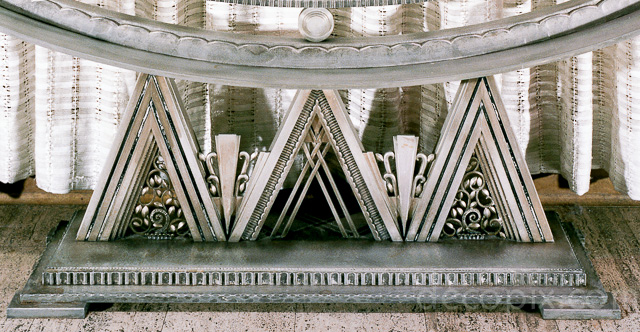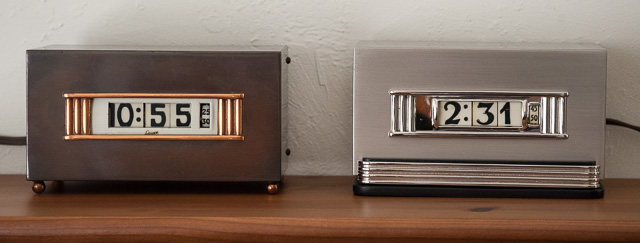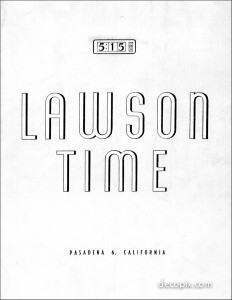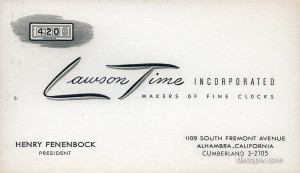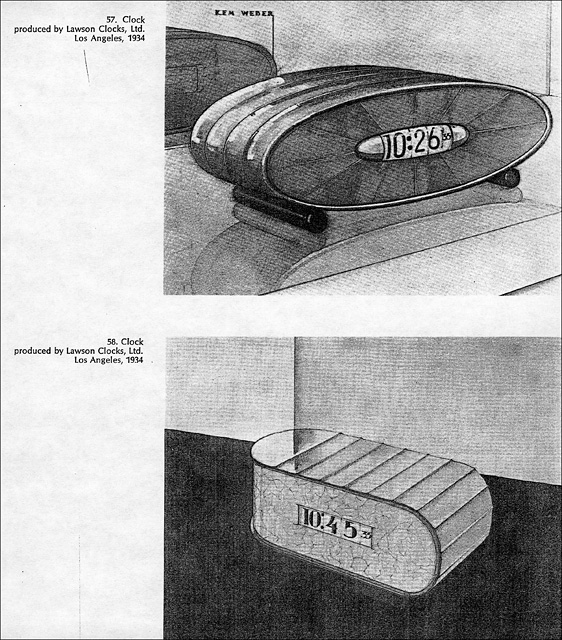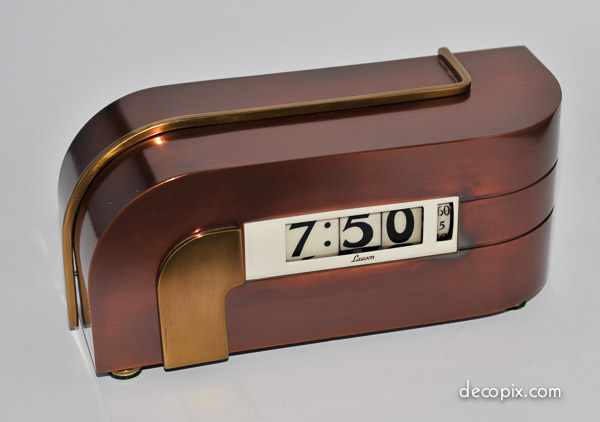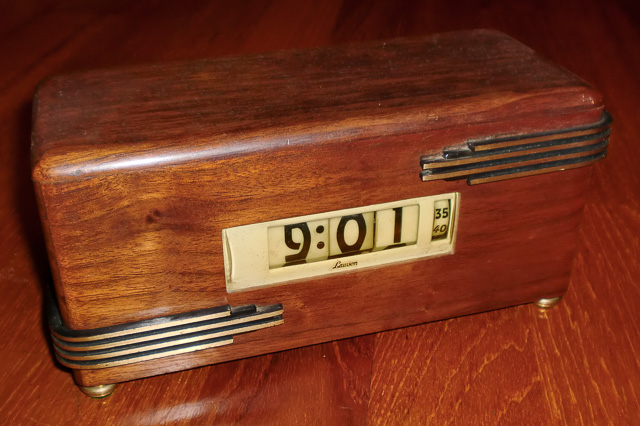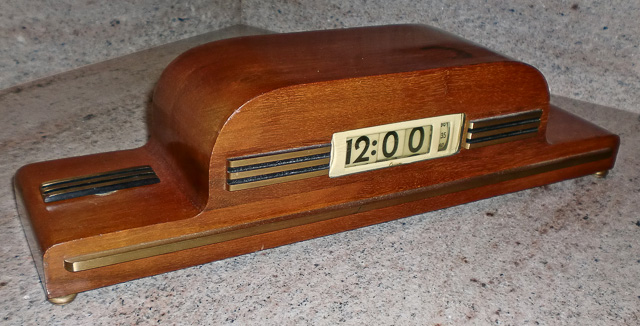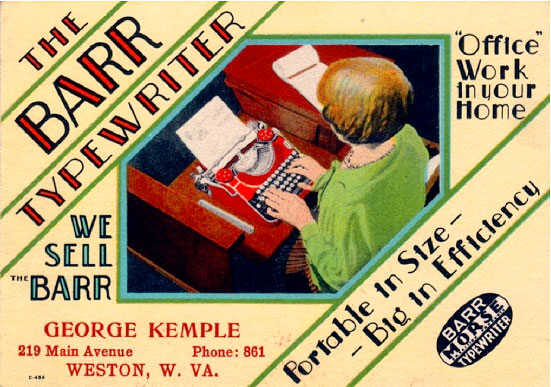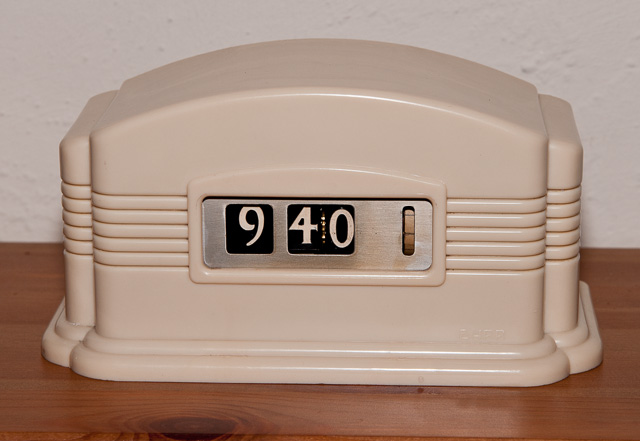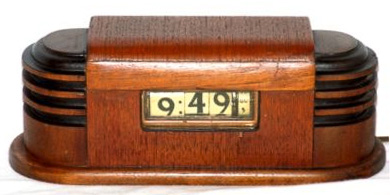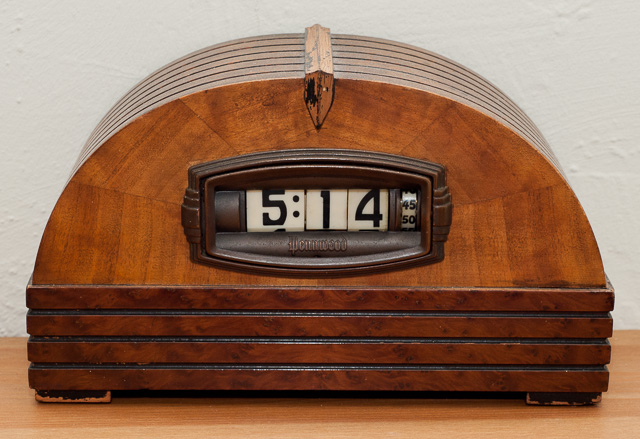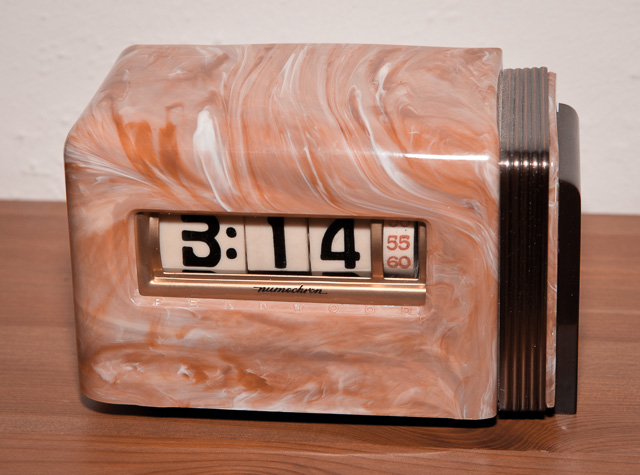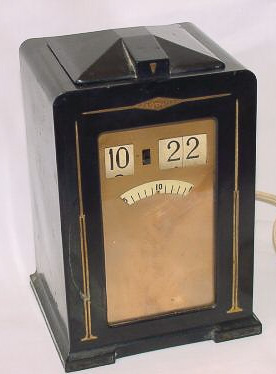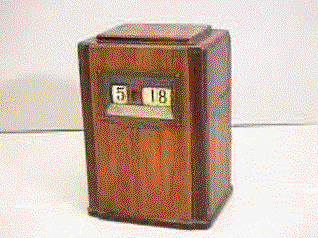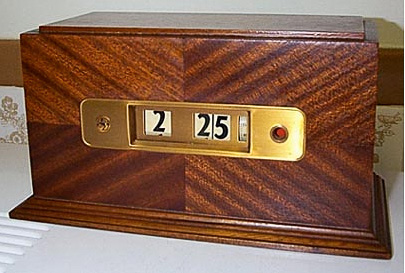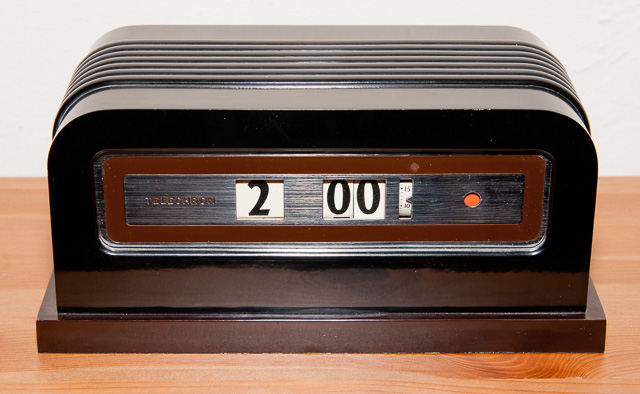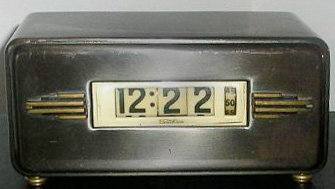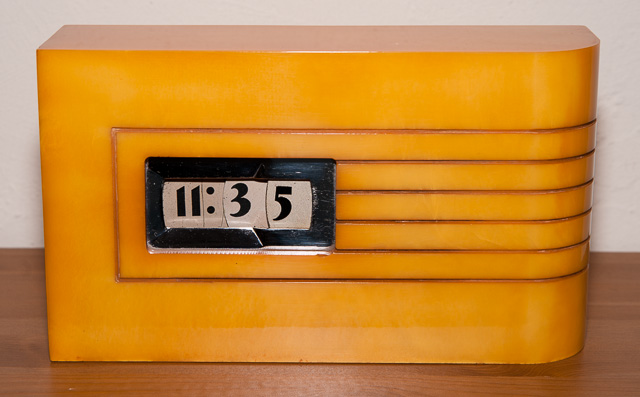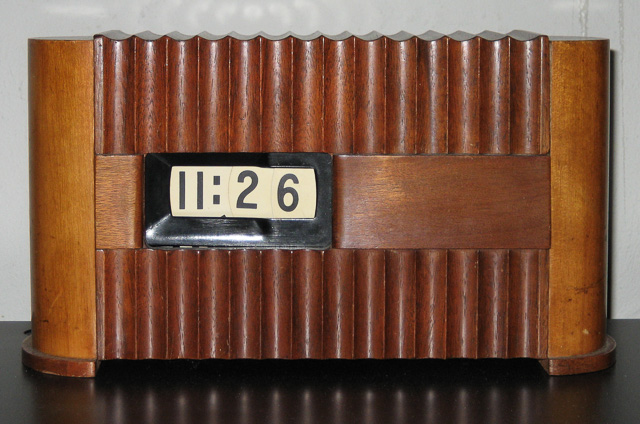With this revision, the Lawson Clock Story has gotten pretty long, so for readers who are not history buffs, here are some shortcuts:
The Kem Weber connection (or lack thereof.)
If you’re really in a hurry, I’ll just tell you Kem Weber had nothing to do with the design of your Lawson clock. If you’re interested in another equally exceptional designer, Paul Feher, or how a very small company successfully made and sold Art Deco clocks for almost 50 years, read on.
First, a huge THANK YOU to all the people who contributed their time and knowledge to make this possible:
W. Scott Braznell who located some of the earliest Lawson trade ads in the Jeweler’s Circular Keystone publication.
Abbey Chamberlain Brach, Curatorial Assistant, Decorative Arts and Design at the Los Angeles County Museum of Modern Art, who found some scarce Lawson ads from the 1930s.
Robert Coombes whose father, H.E. Coombes, Sr., fabricated Lawson’s metal clock cases and who became the second owner of Lawson Time, Inc. in 1940.
Henry Fenenbock whose father owned Lawson Time for longer than anyone else, from 1947 to the company’s final days in 1980.
John Lawson great-grandson of Lindley Spencer Lawson, founder of Lawson Clocks Limited, who graciously provided the Lawson family tree.
Dr. Neil Kuns an expert in all types of clocks but with a particular interest in cyclometers. Neil’s research has been essential to establishing the dates in the Lawson saga.
Dana N. Slawson researcher extraordinaire who uncovered the crucial link between the Lawson Manufacturing Company of Pittsburgh and Lawson Time Incorporated in Los Angeles.
Russell Windle who knows more about 20th century electric locks and design than anyone I’ve ever met. And Russ’ knowledge isn’t limited to clocks, either.
Introduction
Until recently, little was known about Lawson Time, a small southern California manufacturer of digital clocks, predominantly in the Art Deco style. Lawson’s streamlined designs let many to believe the company operated during the 1930s (true, but only partially so) and that Lawson clock cases were designed by Kem Weber (not true.)
Selling expensive clocks during the Depression must have been an accomplishment in itself. But even more remarkable was that Lawson not only survived; it continued operating until 1980. Here, for the first time, is the story of Lawson Time, including the company’s four owners, five locations and 46-year history.
Part One: Displaying Digital Time
Part Two: Frederick Greenawalt’s Invention
Part Three: The Pennwood – Lawson Connection
Part Four: Lawson Clocks Limited
Part Five: Designing Lawson Time: Ferher & Adomatis
Part Six: Lawson Pasadena – Harold Coombes Takes Over
Part Seven: The Mysterious John Beall
Part Eight: Henry Fenenbock and Lawson Alhambra
Part Nine: Lawson Clock FAQs
Part Ten: Other Digital Clocks of Interest to the Art Deco Collector
Part One – Displaying Digital Time
The idea of displaying time digitally has a long history.
In previous editions of this article I mentioned Eugene Fitch’s Plato clock of 1903. But the Plato was a “flip” clock, displaying the time on little plates that flipped like book pages, whereas Lawson clocks were cyclometers, clocks that displayed the time on wheels.
Still, even a search for digital clocks that displayed the time on wheels revealed much earlier timepieces.
Further digging in Google Patents uncovered a digital clock invented by Emil G. Hammer in 1889. Excuse me for saying this clock was “ahead of it’s time” (sorry!) but not only was it digital, it was electric as well–rather audacious, since most people wouldn’t have electricity for another 35 years.
Part Two – Frederick Greenawalt’s Invention
The Lawson Clock story began in 1932 with Frederick A. Greenawalt’s invention of a clock mechanism that worked like a car’s odometer. At the appropriate time, each drum (wheel) advanced the adjacent drum.
From the Circleville(Ohio) Herald, June 2, 1933:
INVENTS ODD CLOCK – The clock has lost its face and hands. That is the result of an invention by Frederick A. Greenawalt of Pittsburgh who has perfected a contrivance which tells time by figures. After two years work, Greenawalt achieved his aim using three drums of different size and bearing figures. The piece is electrically controlled and works much similar to an automobile speedometer.
This little news item contained more information than I realized at first, the key feature of Greenawalt’s clever design. Each drum was a different size.
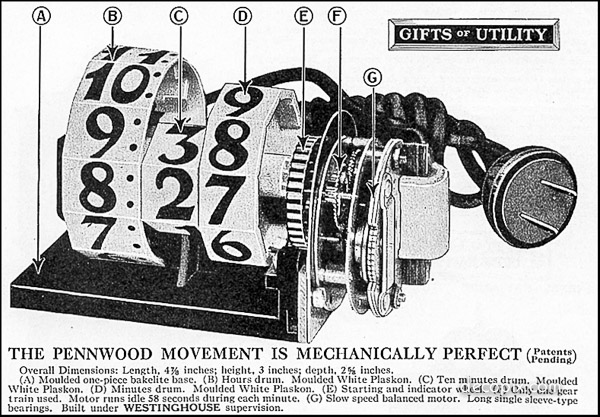
Frederick A. Greenawalt’s “mechanically perfect” design, showing three drums of different sizes plus a fourth, spin-start for the motor. Note that the style (font) of the numbers shown here was not the earliest “spaghetti” script but this is still a very early movement with a Bakelite base. From a 1934 catalog.
Greenawalt’s digital clock would soon have competition. However, the other clocks, from Warren Telechron and Barr Manufacturing had drums that were all identical in diameter which made things much more complicated.
With drums that were the same diameter, each drum would have to rotate a different number of degrees to change the time. This was because the minutes drum had 10 facets (0-9), the tens of minutes drum had just six (0-5) and the hours drum had twelve (1-12).
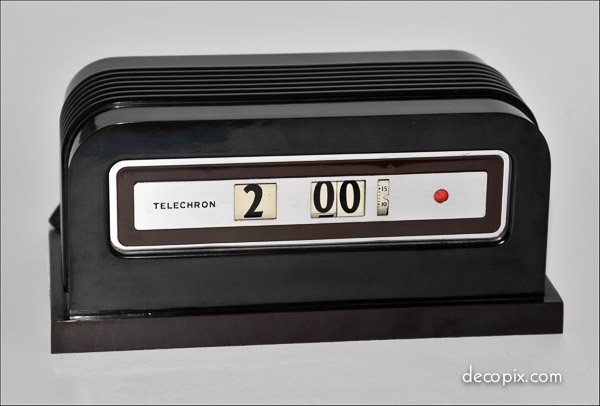
The streamlined case of this handsome Telechron “Baron” conceals a complex mechanism required to advance the drums different amounts, because they are all the same diameter but each has a different number of facets. Case designed by Walter Dorwin Teague with his familiar “ribs”, which are are also seen in his other designs like the Kodak Brownie camera.
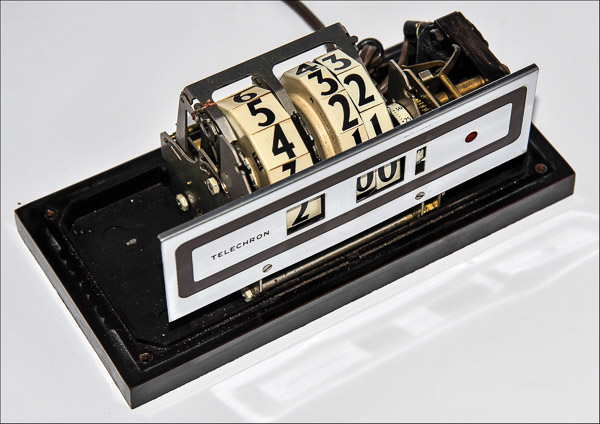
Look closely and you’ll see this Telechron mechanism has to move each drum a different amount to make the numbers line up.
Greenawalt filed his cyclometer clock patent application on March 10. 1933 and received patent 1,990,645 on February 12, 1935. The patent indicates Greenawalt was aware of self-starting clock motors, which were just starting to appear. However, the earliest clocks made by his company, Pennwood, have a wheel that is spun to start the motor. A variation on Greenawalt’s mechanism would be used, but with self-starting motors, in Lawson clocks.
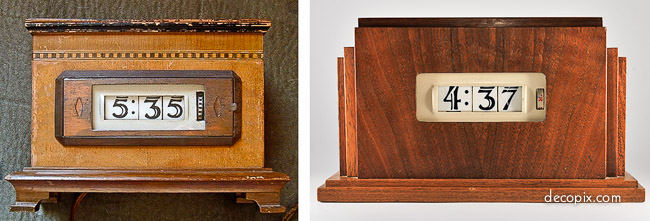
A very early Pennwood clock with a fancy case made by Adler-Royal…and a very early Lawson clock, model 14. The “spaghetti script” can be seen in Greenawalt’s patent but was used only briefly and tells us both clocks are from 1933 or 1934. The Pennwood clock has a wheel, used to start the motor; the Lawson clock self-starts, and the wheel on the right shows the seconds.
It’s interesting to speculate if the idea of a fourth drum displaying the seconds might have originated with Lawson since all Lawson clocks were self-starting. The earliest Lawson clock found, a model 14, has, in addition to the usual plastic drums, a fourth drum made of metal that displays the seconds. (Edgar Bourquin, who designed cyclometer clocks for Telechron, included a seconds display, but his were entirely different designs.)
Even before he received his patent, Frederick Greenawalt put his invention to work, establishing the Pennwood Electric Company in Pittsburgh, Pennsylvania. But how did a nearly identical digital clock mechanism turn up in in clocks made by Lawson Clocks Limited in Los Angeles?
Where did the paths of Pennwood and Lawson cross?
Part Three – The Pennwood – Lawson Connection
In 1933, shortly after Frederick A. Greenawalt established the Pennwood Electric Company, Harold B. Lawson opened Lawson Clocks Limited in Los Angeles. But how were Greenawalt and the Lawsons connected?
The answer, it turns out, is that at one time, they both occupied the same building.
Lawson Clocks Limited was a spinoff off the Lawson Manufacturing Company, a large and successful maker of room and water heaters. Established in Homewood, Pennsylvania in 1901, Lawson had outgrown their original facility and around 1914 built a new, larger factory in nearby Pittsburgh.
Lawson Manufacturing rented a floor to Frederick Greenawalt who assembled his Pennwood digital clocks on the Lawson premises, using plastic drums manufactured by the Plaskon division of the Toledo Scale Company. Early Pennwood clocks had ornate wooden cases from Adler-Royal, a cabinet maker in Kentucky. There were plastic Pennwoods as well, in a surprising variety of plastics: Bakelite (black, brown), Plaskon (white and other colors), Tenite (white, red, brown, silver and marbleized) and a few in marbleized “Beetle” plastic, most likely from American Cyanamid. It’s not known where Pennwood’s metal cases were made.
Apparently, Greenawalt’s relationship with the Lawsons was more than just a tenant. In a legal dispute settled some years later, we learn that Lawson Manufacturing agreed to vouch for Greenawalt’s credit, enabling him to purchase clock motors in quantity.
Interestingly, records show a small number of clock motors were purchased by Lawson, for Lawson’s own use.
Part Four – Lawson Clocks Limited
We don’t know exactly why Harold Lawson set out for California and opened a clock business but Lawson family recollections give us some idea. Harold and Harriet Roger Friday Lawson divorced in 1931 and this left Harold Lawson no particular reason to stay in Pittsburgh.
Harold had seen a lot of the USA and traveled overseas but he had never been to California. Speculation is that after Harold moved out west, his parents visited him in California and Harold convinced his mother and father that California was the ideal place to retire.
As for the clocks, just as the move to California was Harold’s idea, it’s thought that the clock business was his idea as well. Harold was an astute businessman, capable of seeing the potential in anything that could be sold profitably. He would, of course, have been familiar with Greenawalt’s Pennwood clocks and perhaps thought he could do better, especially since he was financially secure at a time when most people, including Greenawalt, weren’t.
When the Lawsons started their business in 1933, economic conditions were terrible. The Depression wore on and it was obvious it wouldn’t be over any time soon. One bright spot, the Chicago Worlds Fair, an early showcase of the streamline moderne style that would be used for many Lawson clocks, was drawing large crowds. In an interesting coincidence, a young concessionaire at the fair, Henry Fenenbock, would eventually be the final owner of Lawson Time, running the company for longer than anyone else, into the 1980s.
But back in 1933, unemployment was at 25%. There was no social safety net to speak of. In 1934, the federal government began insuring bank deposits up to $2500 but this was no help to those who had lost everything in the Crash of 1929. Unemployment insurance didn’t arrive until 1935.
Undeterred, Harold Lawson opened Lawson Clocks Limited at 2329 W. Washington Blvd., Los Angeles.
Why Los Angeles? Given the cost of a Lawson clock, my guess is that Lawson planned on catering to the affluent, many of whom were in southern California. Wealthy retirees, health-seekers, oilmen, ranchers, real estate developers. Paradoxically, the movie business was a beneficiary of the hard times.
Whatever the reason, it was a canny decision to make the clocks in L.A. where non-traditional things were appreciated and at least some people could afford them. How much? A Lawson Zephyr, list priced at $27.50 in 1938 would cost $455.60 in 2013 dollars. And it wasn’t the most expensive model!
Part Five – Designing Lawson Time: Ferher & Adomatis
(and not Kem Weber)
Having mentioned the Zephyr clock, let’s turn to Kem Weber’s Lawson connection or lack thereof.
Kem (Karl Emanuel Martin) Weber (1889-1963) was a German desinger, much of whose work exemplified the streamlined “moderne” style. Weber came to the U.S. to supervise the construction of Germany’s exhibits at the 1915 Panama Pacific Exposition in San Francisco. With the outbreak of World War I, Weber found himself stranded in California.
Kem Weber eventually made his way south, settling in Santa Barbara and frequently working in Los Angeles.
Kem Weber was a prolific and tireless promoter of his work. But as his biography makes clear, his designs, especially the modern ones, met with a great many rejections due to both the poor economy and client’s reluctance to try something new.
It has been reported that Kem Weber was fond of Lawson’s Zephyr clock, introduced in 1937 as the dull sounding Mayfair. But there is nothing to indicate he was involved with the Zephyr or any other Lawson design that was actually produced.
On the contrary, the following year, Lawson’s 1938 catalog attributed the clock designs, including the Zephyr, to “Ferher and Adomatis” whose names are displayed prominently. To think that Weber was overlooked so that two lesser-known individuals could be recognized makes no sense.
The Kem Weber archive at U.C. Santa Barbara has several Lawson clock drawings (along with many other designs that were never realized) and it’s certainly possible Weber was hired to submit his ideas to Lawson. But having read his biography, it seems more likely he made these drawings in an attempt to interest Harold Lawson and for unknown reasons, he declined.
Still, the story that Kem Weber was involved in the design of clocks actually produced by Lawson persists, due to this attribution in a 1969 catalog on Weber’s work, and and that unassailable source of knowledge, eBay.
By the way, for those who see Kem Weber’s modernistic hand in every Lawson design, I’ll point out that some were far from modern in appearance:
At the other extreme, the Zephyr’s “wave” shape wasn’t exactly unique:

Left to right: Lawson Zephyr, “Chronotherm” thermostat proposed by Henry Dreyfuss for Minneapolis Honeywell, Zenith “Wavemagnet” radio designed by Robert Budlong
And speaking of designers, it appears Lindley Lawson was a capable modern designer himself. His 1930 drawing for a heater looks like a rocketship!
So, who were the designers of Lawson clocks, Ferher and Adomatis?
Is my Kem Weber clock really a Paul Feher clock? I think so.
Even today, designers frequently go uncredited unless they are celebrities. So we should give the Lawsons credit for giving two obscure individuals their due. But who were they? When I first saw “Ferher and Adomatis” I instantly thought of Paul Feher, the brilliant Hungarian designer and metalsmith who worked at the Rose Iron Works in Cleveland. But there were two problems. First, the spelling of the name. There was no second “r” in Feher. A bigger problem was that due to a lack of creative work following the stock market crash, Paul Feher left Rose Iron Works in the early 1930s, returning to Hungary.
The trail went cold until someone who had studied Paul Feher explained that, finding limited work in Hungary, Feher had returned to the US. And, after a brief stint on Long Island, Paul Feher headed for Los Angeles. Right time, right place. But what about the spelling of the name? This appears to simply be an error, as searches for a “Ferher” produce no results. For more information on Paul Feher, click here.
So Paul Feher worked in Cleveland and ultimately made his way to Los Angeles. But was he the “Ferher” of Ferher and Adomatis cited in Lawson Time’s catalog? Yes.
According to research from the Yale University Art Gallery, the other member of the team, George F. Adomaitis (sic?) was an obscure designer employed by Lawson. (Like Feher, Adomatis had lived and worked in Cleveland. Adomatis was an artist as well; the Cleveland Museum of Art has three of his watercolors from 1933.)
To summarize, we have Lawson Clocks Limited, established in 1933, Paul Feher, having worked in Cleveland, arriving in L.A. c.1935, George Adomatis, positively identified as one of Lawson’s designers, also from Cleveland, moving to Los Angeles at roughly the same time. Both men appear in the Los Angeles 1936 city directory, and both men are cited in Lawson Time’s 1938 catalog–which features, among other things, the Zephyr clock.
Furthering the Paul Feher – George Adomatis connection, itn turns out both men lived at the same address! Both are listed as as Art Designers, living at 1828 S. Van Ness Avenue, just a few blocks from the Lawson factory.
Here are photos of Feher’s extraordinary screen that served as the centerpiece of the Smithsonian’s American Art Deco exhibit in 1988. Also, a Feher table. Many consider Paul Feher’s work to be at the pinnacle of American Art Deco.
One more point about Lawson designs. Many Lawson clocks had parts in common. Some model variations were so minor it’s likely there was no designer at all. For example, this simple and attractive model 200 and the jazzier model 202 are the same clock, except the 202 substitutes a black lacquered base and chromed strip in place of the ball feet on the 200.
Part Six – Lawson Pasadena – Harold Coombes Takes Over
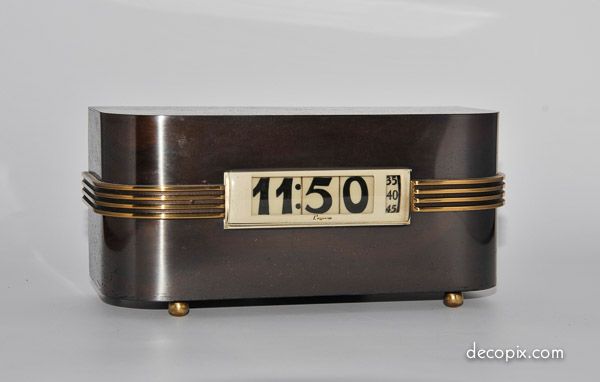
Lawson model 460 made in Pasadena. Note the ball feet and very dark brown finish, found on earlier Lawsons.
While the Lawson clock story spans fifty years, you may be surprised that the Lawsons were part of the picture for just seven.
Harold E. Coombes, the owner of Crown City Plating in Pasadena, California fabricated and finished the metal cases for Lawson clocks.
In 1940, the Lawsons exited the clock business, handing over Lawson Time Incorporated to Coombes as payment owed for clock cases he had completed. The Lawsons probably foresaw U.S. involvement in World War II but whether this affected their decision is not known.
Coombes consolidated Lawson’s production, moving the Los Angeles facility to Pasadena, across the alley from the plating works at 165 South Fair Oaks Blvd.
The war’s arrival interrupted clock production, with the Lawson/Crown City facility turning its attention to anodizing, airplane parts and and rivets for the war effort.
Part Seven – John Beall & Harry Eder
Records show that shortly after the war, Lawson Time changed hands again, this time to John Beall. Until recently, it was thought that all of Lawson’s Pasadena-manufacturered clocks were made by Harold Coombes during he brief period between the Lawsons transferring the business to Coombes (1940) and the U.S. entry into the war. But it turns out, Lawson Time filed an official suspension of business in January 1941, so it’s doubtful many Lawson Pasadena clocks were made before World War II.
A recently discovered Lawson catalog shows the company at a different Pasadena address, with a limited number of offerings. In 1946, John Beall and Harry Eder revived the clock business, manufacturing clocks in Pasadena until the business was sold to Henry Fenenbock in 1948.
Part Eight – Henry Fenenbock and Lawson Alhambra
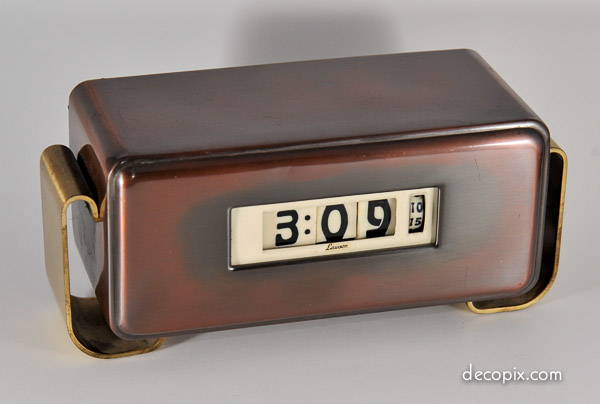
Lawson model 309. Made in Lawson’s Alhambra factory, the 309 is suspended on brushed brass legs. The legs remind me Art Deco desks and tables from the 1930s.
In addition to Paul Feher and George Adomatis, one other important figure in the Lawson clock story arrived in Los Angeles around 1936. Henry Fenenbock, the young entrepreneur who sold souvenir turtles at the Chicago Worlds Fair also made his way to L.A.
In those days, good penmenship and a high quality fountain pen were essential for successful businessmen and Henry, who had always been interested in pens, opened Swanee’s Pen Hospital (named after a favorite song). “Swanee” as Henry would come to be known, would go on to build a huge business becoming the largest Parker pen dealer in the world, ultimately owning a part of Parker and all of Lawson Time.
(Henry also tried his hand in real estate, purchasing a commercial building in a newly developed area called Beverly Hills. This investment turned out rather well also, but that’s a story for another time).
Meanwhile, Henry Fenenbocks’s pen business continued to grow and, always on the lookout for a great opportunity, he became the fourth and final owner of Lawson Time in 1948, relocating the business to 1109 South Fremont Avenue, in Alhambra, California. The factory had excess capacity so Henry set up an operation making onyx and black glass desk sets for Parker.
With Parker Pen’s steady orders coming in, Henry was able to continue producing beautiful Lawson clocks. To the surprise (and some dismay) of Lawson collectors, the Lawson Alhambra facility continued making distinctly Art Deco clocks until sometime in the late 1960s and the walnut cased clocks were produced in small quantities until 1980! With this long run, it’s no surprise the majority of Lawson clocks were made in Alhambra.
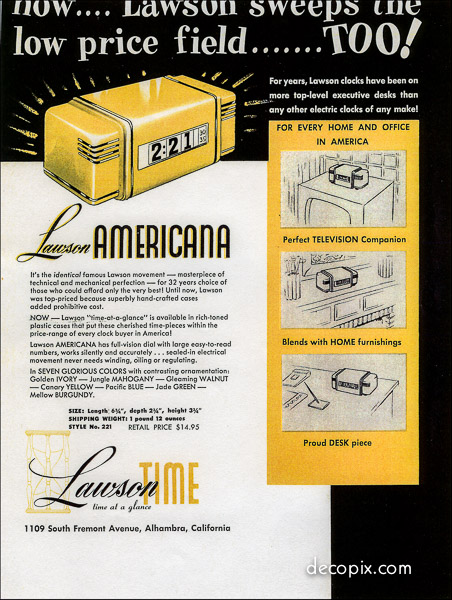
Lawson Americana, c.1954. Henry Fenenbock resurrected the only plastic cased Lawson, originally known as the Empress. Minus the Empress’ metal trim, the new, lower cost Americana was aimed at consumers who wanted a genuine Lawson but were on a budget.
By the 1970s, good quality, inexpensive clocks from Japan made Lawson clocks seem extravagant. With the assistance of expert woodworker Cecil Blackwood, Henry Fenenbock continued making small quantities of wood-cased Lawson clocks.
In September 1979, the business relocated one last time, to 5466 Alhambra Avenue in Los Angeles. Prior to the move, the equipment used to manufacture clock parts was dismantled and salvaged, so any clocks made at the Los Angeles location were assembled from leftover parts. Some Lawson parts were still being provided to Otis Elevator and other companies to be incorporated in their products. Henry Fenenbock was in poor health, and in 1980 he closed the Alhambra Avenue operation and sold the building, effectively ending Lawson Time, Inc.
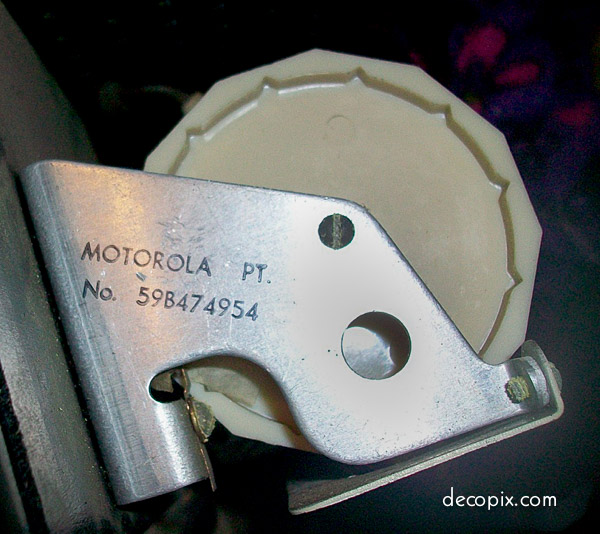
Lawson clock mechanism sold as a Motorola replacement part. What Motorola product used this part is not known.
With their sleek designs, many unchanged throughout the years, Lawson clocks are an unusual example of how the streamline style kept a loyal following from post-Depression Art Deco, through 1950s aerodynamics and finally into the space age.
And what about the Lawson (heater) Manufacturing Company that started it all? It seems almost everyone in the Lawson clock story ended up in Los Angeles. Lindley Lawson retired from Lawson Manufacturing Company and moved from Pittsburgh to Los Angeles where he passed away on May 12, 1954. His son Lynn ran Lawson Manufacturing until December 1959, when it was sold to Wilson Brothers, Inc.
A photo gallery of Lawson clocks can be found here.
Part Nine – Lawson Clock FAQs
Q: Was my Lawson clock made in the 1930s?
A: Yes, if it was made in Los Angeles. No, if it was made in Pasadena or Alhambra. Specifically:
Los Angeles 1934-1940
Pasadena 1940-1948
Alhambra 1948-1979
Los Angeles 1979-1980
These dates may not be absolutely precise but we know from both articles of incorporation and phone directories where the company was and when.

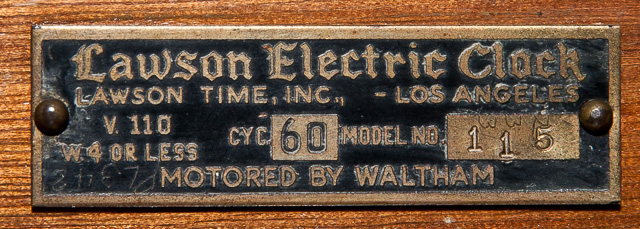
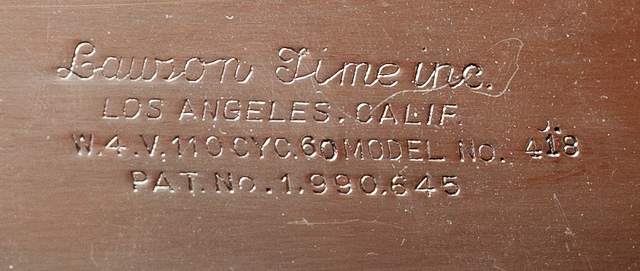

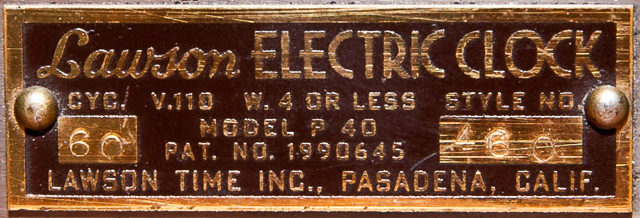
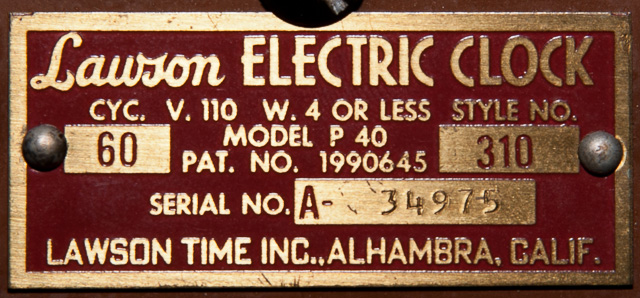

Q: Was my Lawson clock designed by K.E.M. Weber?
A: Weber made a few drawings of proposed Lawson clocks. It is not known if he was hired to do this or simply approached the company with his designs. No clocks matching his drawings have surfaced.
The Zephyr clock, most frequently attributed to Weber is shown in Lawson’s 1938 catalog where the designers are credited (prominently) to “Ferher and Adomatis”. It has been confirmed that Adomatis was George Adomatis, an obscure designer and I believe Ferher was in fact Paul Feher, the great Art Deco designer and metalsmith.
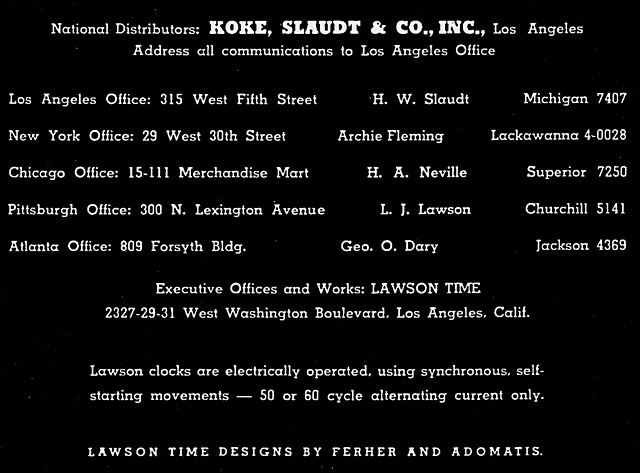
Q: Is my Lawson clock rare?
A: You’ve probably noticed, everything on eBay is RARE. Still, it’s fair to say most Lawson models truly are somewhat scarce, with certain finishes less common. It’s easier to point out the three that turn up frequently. Most surprising is the striking and desirable Zephyr (below). This model was made at all three Lawson factories and I have seen as many as four on eBay at the same time. The earliest 1930s Zephyrs are a bit different, with the style 1b numbers (see below) and ball feet. The Zephyr, in “copper/bronze” finish, is among the most desirable yet easiest to find Lawson models.
Also common is the Sierra (also called the Sportsman) model 215. Its worth noting that early versions of model 215 had a different case, taller and with ball feet, compared to the later versions of this popular model.
Finally, there is the New Yorker, model 940. Unlike the iconic Zephyr or inexpensive Sierra, the New Yorker doesn’t give any obvious clues to its popularity but it had a long run in both Pasadena and Alhambra. Henry Fenenbock has a version of this clock in a wooden case and his, I suspect, really is rare–perhaps a prototype.
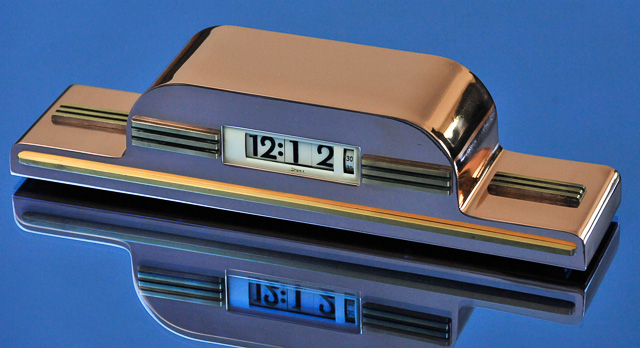
Lawson 490 or 940, “New Yorker”. This clock’s copper/bronze finish has been polished to reveal the underlying copper.
Q: When a seller says a Lawson metal cased clock has a few spots that can be “buffed out” is this true?
A: Unfortunately, no. Lawson metal clocks have a lacquer coat and while its tougher than the environmentally friendly lacquers in use today, if a clock has a worn or tarnished finish, that means some of the lacquer is gone. Additional lacquer can be applied but won’t fix any flaws and tends to give a cloudy look.
I have been told it is possible to strip the original lacquer without harming the finish underneath. Henry Fenenbock says he’s had this done by F&H Plating in North Hollywood. This might be an alternative to totally refinishing. There are a few Lawson clocks with steel finishes that won’t discolor even without lacquer but with brass, copper and nickel, lacquer is essential to prevent tarnishing.
Q: Does refinishing a Lawson clock reduce its value?
A: This is where I say an item is worth what someone is willing to pay for it. If the original finish is mostly intact, it would seem foolish to alter it. On the other hand, I have seen exquisitely refinished clocks that looked a lot nicer than others whose “original patina” was badly beat up. Beauty is in the eye of the beholder. By the way, its also possible that some Lawson clocks were made with custom or non-standard finishes.
Q: What causes the darkening that surrounds the numbers window on the copper-bronze finished clocks?
A: The popular copper-bronze finish was produced by oxidizing copper and then buffing off the oxidation to reveal a brighter brown color. By buffing less in the window area, this section would remain dark. Note that the early, Los Angeles-made copper/bronze clocks are uniformly dark and do not show additional darkening surrounding the window/numbers area.
Q: What does it mean when someone says the clock was recently cleaned and oiled?
A: This sounds like something one would do to service a mechanical clock. Since we are talking about electric clocks the only thing that could be oiled would be the motor and if its working, I wouldn’t. You can try a drop or two of an ultra-light lubricant like liquefied molybdenum or graphite but be advised that after years of wear, lubricating an old motor that’s working will often just make it noisier–the worn parts have more room to rattle around. As for cleaning, see next question.
Q: Can I clean the number wheels?
A: Not always, but sometimes. The numbers on Lawson clocks are surprisingly durable! Occasionally, you will see the paint starting to blister and in that case, you’re out of luck. With the disclaimer that I am not responsible for any mishaps, try a very soft cloth and a small amount of a totally non-abrasive cleaner. I use Brillianize. Usually, its only necessary to clean the white (ivory) portions of the wheels. If you feel the need, you can try cleaning the numbers themselves but do this very gently–repainted numbers look awful.
Q: Are the parts inside a Lawson clock interchangeable?
A: Many are, and that’s why it’s generally not possible to date a clock by the internal mechanism. The earliest Lawson clocks–the ones that say “Motored By Waltham” use a mechanism that is smaller than the later clocks and some very early clock cases are too small to accept the mechanisms from later clocks. Also, some of the Motored By Waltham clocks use the diagonally offset mounting screws that are typical of most Pennwood clocks, not the side-by-side mounting screws found on all other Lawsons.
Q: What does “Model P-40” that appears on all Lawson clocks from about 1940 on, mean?
A: I’m sure there’s a simple explanation but I don’t know. Probably just a coincidence, but the factory relocated to Pasadena in 1940.
Q: When and where did the style of the numbers change?
A: This is imprecise but here is the sequence, with approximate dates. Remember that in most cases, these mechanisms can be swapped so they aren’t reliable indicators of the age of the clock.
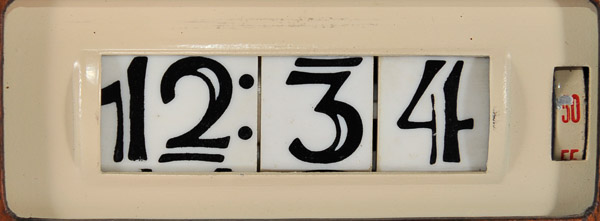
Style “0” c.1934. White plastic wheels with enameled metal disc for display of seconds. Clock tagged Motored by Waltham. Very uncommon. A recently discovered Lawson clock, model 14, features numbers in this style–the same as pictured in Frederick Greenawalt’s patent. Very early Pennwood clocks use this style as well, but minus the seconds wheel.
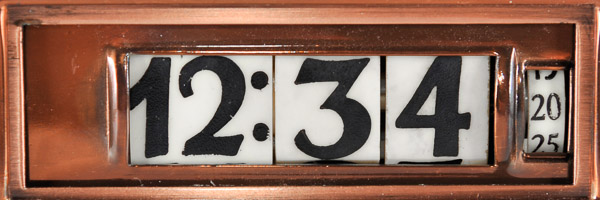
Style 1a. 1934-c.1935. “Motored by Waltham” models. White plastic wheels with copper or chrome escutcheon.

Style 2. c.1947-c.1960s. Post-war numbers. By far the most common. Most Lawson clocks have this style, including many older clocks that have had their numbers changed to replace an older mechanism that has failed.

Style 3. c1970s-1980s. A simplified, post-Art Deco style. Not terribly common, suggesting production may have been nearing the end.
Q: What is my Lawson clock’s case made from?
A: The vast majority of the wooden clocks have walnut cases. This is a high-quality “hand rubbed” oil finish with a satin to semi-gloss appearance. A much smaller number of the wood clocks were made with mahogany or light ash. A very small number of early clocks have the fancy, shiny wood veneers that were popular in the 1930s and 1940s.
Lawson metal cases are almost always entirely brass. Occasionally, some flat pieces such as bottoms or backs are steel. While the most popular Lawson finish was “copper bronze” I have yet to find any bronze in a Lawson clock. The uncommon “gold” finish is in fact, a bright brass with a gold tint or “wash”. There is no real gold in Lawson’s gold finish.
Q: What finishes were available on the metal clocks?
A: Finish choices varied with the model and the time period. Besides the popular copper-bronze (actually oxidized “antiqued” copper over brass), clocks were offered in brushed nickel, brushed silver, gunmetal (uncommon) and gold (uncommon). The “gold” appears similar to the bare brass seen in clocks whose finish has been stripped, however, the gold finish has a yellowish tint, a sort of gold “wash” that sets it apart from bare brass.
Bright copper (quite attractive, in my opinion) was not offered. These days, bright copper is often seen since it’s what you get if you polish a copper-bronze clock and brighten up/remove the oxidation. I don’t believe chrome was offered either, except for some trim and on on the back plates of some mirror faced clocks. Early on, metal trim on Lawson clocks was typically brass plated with copper, chrome or nickel. A very few clocks had gold plated trim. But soon, it appears Lawson decided to standardize on stain brass trim.
Part Ten – Other Digital Clocks of Interest to the Art Deco Collector
Barr
A manufacturer of typewriters and then clocks, Barr Manufacturing of Weedsport, NY made at least two digital models. One had wooden case of rather plain design; the other, a plastic model, offered an attractive streamlined look and came in black, brown and white.
Barr digital clocks are somewhat uncommon and even more uncommon in good working order. Barr’s mechanism was unique. The wheels were metal and they interlocked via gear teeth on the inside of the wheels. If you dissemble a set of Barr wheels, be prepared to spend an evening trying to reassemble them in proper orientation. Even with proper assembly, the Barr mechanism had difficulty positioning the facets of the wheels so the numbers lined up properly. Click here for Barr’s patent.
Interesting trivia: (1) Although the wheels were metal, the numbers on some Barr digital clocks were printed on plain paper that was glued to the wheels. (2) The Barr’s inventor, E.M. Goldsmith, Jr. worked for M.M. Gottlieb Associates, who made the Telometer clock (see below). (3) E.M. Goldsmith, F.A. Greenawalt (inventor of the Pennwood/Lawson mechanism and Lindley Lawson were all from Pennsylvania.
Pennwood
No company did more to popularize the rolling wheel digital clock than Pennwood. Lawson and Pennwood produced clocks for about the same length of time but dating Pennwood clocks is easier since most were were marked with their date of manufacture. Initially, this was done with a label and starting in the 1940s, with a decal or rubber stamp.
The patent for the mechanism used in Pennwood (and Lawson) clocks was granted to Frederick A. Greenawalt, an employee or associate of the Pennwood Company. Greenawalt’s patent, issued in February 1935, closely resembles the mechanisms that ended up in Lawson and Pennwood clocks with the exception that he did not specify a type of motor. Initially, the motors and gearing came from the Waltham Watch Company. Waltham also made odometers so it’s likely they made the clock wheels as well. Click here for Greenawalt’s patent.
Although Pennwood and Lawson clocks had nearly identical mechanisms, over the years the two companies diverged in their approach to the clock market. The earliest Pennwood clocks were high-end models with fancy cases. However, in the 1940s, Pennwood shifted its emphasis to less expensive models, many with plastic cases. When TV became commonplace, Pennwood caught the wave with a series of novelty clocks shaped like little TV sets. Although these TV clocks haven’t been made for decades, so many were sold that they are still commonplace. Many early Pennwood clocks were Art Deco in style and even some 1950s-1970s models had a vaguely Deco appearance.
A later model that really did have a Deco look was the appropriately named Moderne. Attributed to designer Peter Muller-Monk, the Moderne was made in white, pink, tan, mottled walnut, silver-gray and a marbleized coral color. While nowhere near as common as the TV clocks, the Moderne was made as early as 1941 and still available in the early 1960s.
Interesting trivia: (1) Only the very earliest Pennwood clocks have all-black numbers. Early on, the switch was made to having the seconds displayed in red. Pennwood had other color schemes as well but never returned to all-black. (2) Pennwood clocks often have repeating design elements. The small triangle at the top of the #1364 above is actually the Pennwood crest which also appears as a decal on the back of the clock. The base on the pen & pencil set has the same “wings” on the sides as the clock case has. (3) The earliest (and nicest) wooden Pennwood cases were made by Adler-Royal, a New York radio manufacturer who made radio cabinets in their Louisville, Kentucky plant.
Smith Metal Arts (SMA, Silver Crest, Moon Crest)
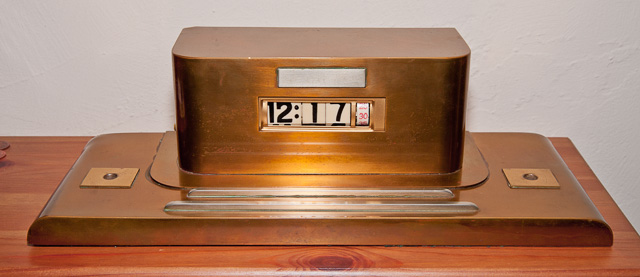
A Silver Crest desk clock. These clocks could be fitted with either Pennwood or Lawson mechanisms and were apparently sold with both.
Smith Metal Arts of Buffalo, New York has the distinction of being the only manufacturer discussed here that still operates under its own name producing the type of goods it traditionally made including desk sets. In the 1940s-60s, Smith made a line of desk accessories including clocks. Smith’s clock designs were more conservative than Lawson’s and I suspect that’s why their clocks, particularly the Silver Crest models (which aren’t silver in composition or color, by the way) turn up so often–they probably appealed to a larger audience.
Henry Fenenbock was eager to sell stand-alone Lawson clock mechanisms and Smith was one of his customers, using the Lawson wheels and motors just as they received them, with Lawson’s decal. Smith also bought clock movements from Pennwood and some Silver Crest and Moon Crest cases are drilled with 4 mounting holes, to allow either Lawson or Pennwood mechanisms to be used. Nontheless, Smith Metal Arts clocks are Smith Metal Arts clocks; they were not manufactuered or sold by Pennwood or Lawson, who had more than enough models of their own.
Interesting trivia: (1) The metal strip on the clock pictured above was for engraving the owner’s initials. (2) Designer Peter Muller-Monk designed some Smith Metal Arts’ products and he also designed several Pennwood clock cases. (3) As with Goldsmith, Greenawalt and Lawson, Muller-Monk was also a Pennsylvania resident. Many (all?) Silver Crest clocks are marked “202” so this obviously isn’t a model designation.
Telechron (Warren Telechron, General Electric, G.E.)
If the Pennwood/Lawson clock mechanism was a model of simplicity, at the other extreme were Telechron’s digital models which, with their complex all-metal mechanisms are a wonder to behold. The history of Henry Warren and his Ashland, Massachusetts company is worthy of a book. Fortunately, there is one. I highly recommend Jim Linz’ Electrifying Time.
Although cyclometer clocks were by no means the mainstay of Telechron’s product line, the company did market a number of models from as early as 1933, to World War II. Interestingly, after the war, during 1946-48, Telechron/G.E. offered two more digital models…and these appear to have been made from parts supplied by Lawson. There were vertical Telechron cyclometers and later, horizontal models. At least two models were designed by Walter Dorwin Teague, the man who brought the modern look to Kodak, Ford and Texaco, among others. Warren kept the patent office busy. For Edgar Bourquin’s patent for the vertical cyclometer, click here.
For John Rainbault’s patent, click here. For Teague’s patent on the Baron design, click here.
Interesting trivia: (1) For clocks, self-starting motors were a mixed blessing. If the power failed and was then restored, a clock with a self-starting motor would resume working with no indication that anything had gone wrong. The red indicator dot mechanism, invented and patented by Warren, gave fair warning that although the clock was running, the time might not be correct. (2) The two Telechron/G.E. models that appear to have been supplied by Lawson have unique riveted feet and motors with sealed rotor mechanisms in the Telechron tradition.
Winslow Manufacturing Company
Frederick Greenawalt’s cyclometer mechanism used Lawson and Pennwood clocks made him the undisputed king of early digital clock engineers, but his rolling wheel design was not his only contribution. In 1942, Greenawalt, now living in Columbus, Ohio patented a completely different design that relied on a series of flat discs.
This arrangement, first used in Winslow digital clocks, allowed for an unusually slim case. Also unusual was that Winslow’s cases were made of Catalin, an early plastic capable of achieving extremely rich colors. Supposedly, many colors were offered but so far I have seen only white (which, with Catalin, when exposed to UV light, turns butterscotch) and a marbleized walnut color. Due to the case design, Winslow clocks typically develop cracks but if one is lucky they are not visible from the front.
Interesting trivia: (1) The Winslow mechanism made a second appearance in a wooden cased model called the Telometer. (2) A curious and surprising (at least it was to me) feature of the Winslow mechanism is that the minute disc turns in the opposite direction from the other two discs.
M.M. Gottlieb Associates (Telometer)
It may be a stretch to call the Telometer an Art Deco clock but the reason the Telometer is included here is that it appears to have been the final resting place for the design used in the Winslow clock. The mechanisms in the Winslow and the Gottlieb’s Telometer are the same, but we can tell from the 1950s-style numbers on the wheels that the Telometer came later. Whatever its style, the Telometer’s elaborate wooden case is impressive and rather attractive, I think.
©2010-2015 Randy Juster. All Rights Reserved.
